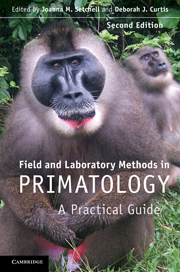Book contents
- Frontmatter
- Contents
- List of contributors
- Foreword by Robert D. Martin
- Introduction
- 1 An ethnoprimatological approach to interactions between human and non-human primates
- 2 Habituating primates: processes, techniques, variables and ethics
- 3 Habitat description and phenology
- 4 Geographical information systems and remote sensing
- 5 Monitoring local weather and climate
- 6 Survey and census methods: population distribution and density
- 7 Trapping primates
- 8 Handling, anaesthesia, health evaluation and biological sampling
- 9 Morphology, morphometrics and taxonomy
- 10 Marking and radio-tracking primates
- 11 Field experiments with non-human primates: a tutorial
- 12 Feeding ecology, frugivory and seed dispersal
- 13 Dietary analysis I: food physics
- 14 Dietary analysis II: food chemistry
- 15 Collecting arthropods and arthropod remains for primate studies
- 16 Recording primate vocalizations
- 17 Photography and video for field researchers
- 18 Chronobiological aspects of primate research
- 19 Thermoregulation and energetics
- 20 Field endocrinology: monitoring hormonal changes in free-ranging primates
- 21 Collection, storage and analysis of non-invasive genetic material in primate biology
- 22 Tips from the bush: an A–Z of suggestions for successful fieldwork
- Index
- References
21 - Collection, storage and analysis of non-invasive genetic material in primate biology
Published online by Cambridge University Press: 05 June 2012
- Frontmatter
- Contents
- List of contributors
- Foreword by Robert D. Martin
- Introduction
- 1 An ethnoprimatological approach to interactions between human and non-human primates
- 2 Habituating primates: processes, techniques, variables and ethics
- 3 Habitat description and phenology
- 4 Geographical information systems and remote sensing
- 5 Monitoring local weather and climate
- 6 Survey and census methods: population distribution and density
- 7 Trapping primates
- 8 Handling, anaesthesia, health evaluation and biological sampling
- 9 Morphology, morphometrics and taxonomy
- 10 Marking and radio-tracking primates
- 11 Field experiments with non-human primates: a tutorial
- 12 Feeding ecology, frugivory and seed dispersal
- 13 Dietary analysis I: food physics
- 14 Dietary analysis II: food chemistry
- 15 Collecting arthropods and arthropod remains for primate studies
- 16 Recording primate vocalizations
- 17 Photography and video for field researchers
- 18 Chronobiological aspects of primate research
- 19 Thermoregulation and energetics
- 20 Field endocrinology: monitoring hormonal changes in free-ranging primates
- 21 Collection, storage and analysis of non-invasive genetic material in primate biology
- 22 Tips from the bush: an A–Z of suggestions for successful fieldwork
- Index
- References
Summary
WHY NON-INVASIVE?
Non-invasive genetic analysis using new, high-precision molecular tools has been an extremely important recent development in primatology, with the promise of pioneering studies in the early–mid 1990s (see, for example, Morin et al., 1994) now being realized at the level of large-scale population studies over broad spatial scales (see, for example, Constable et al., 2001; Anthony et al., 2007b). However, it remains technically demanding, time-consuming, expensive and prone to error. Here, we introduce the applications of non-invasive genetics in primatology, then cover protocols for the most common non-invasive sample types, including faeces, urine and hair, outlining the limitations, pitfalls, and methodologies required. We also describe storage protocols for other possible sources of DNA (deoxyribonucleic acid), including blood and tissue biopsy samples for occasions when animals are captured and handled (Chapters 7 and 8).
APPLICATIONS
Molecular phylogenetic studies continue to add to our knowledge of primate diversity, evolution and hence adaptation (see, for example, Burrell et al., 2009). Phylogenetic analysis can also be used below the species level to study the underlying biogeographical factors that have contributed to the diversity present in primate populations today. This approach has been used to highlight new, evolutionarily distinct populations within well-studied species and to pinpoint potentially important geographical barriers that may delimit genetic divergences across the range of species (see, for example, Gonder et al., 1997).
- Type
- Chapter
- Information
- Field and Laboratory Methods in PrimatologyA Practical Guide, pp. 371 - 386Publisher: Cambridge University PressPrint publication year: 2011
References
- 3
- Cited by



